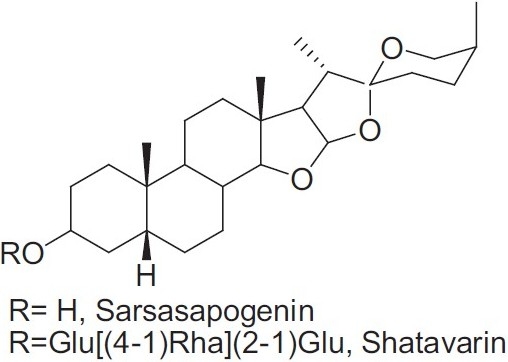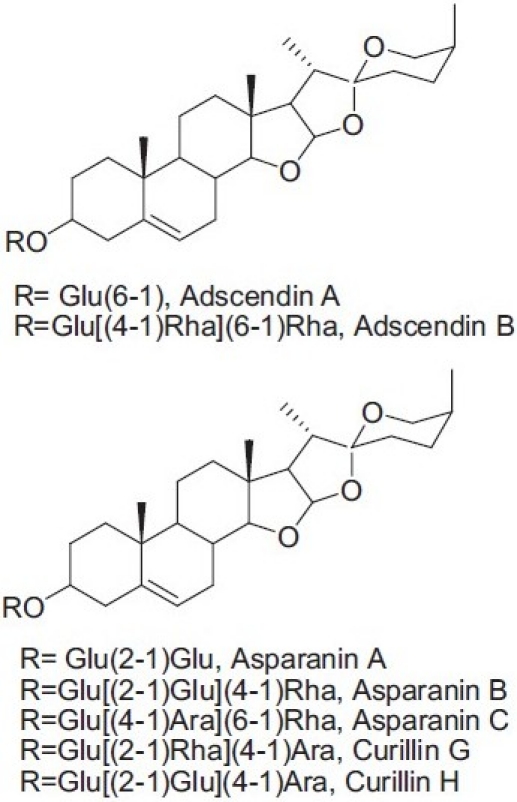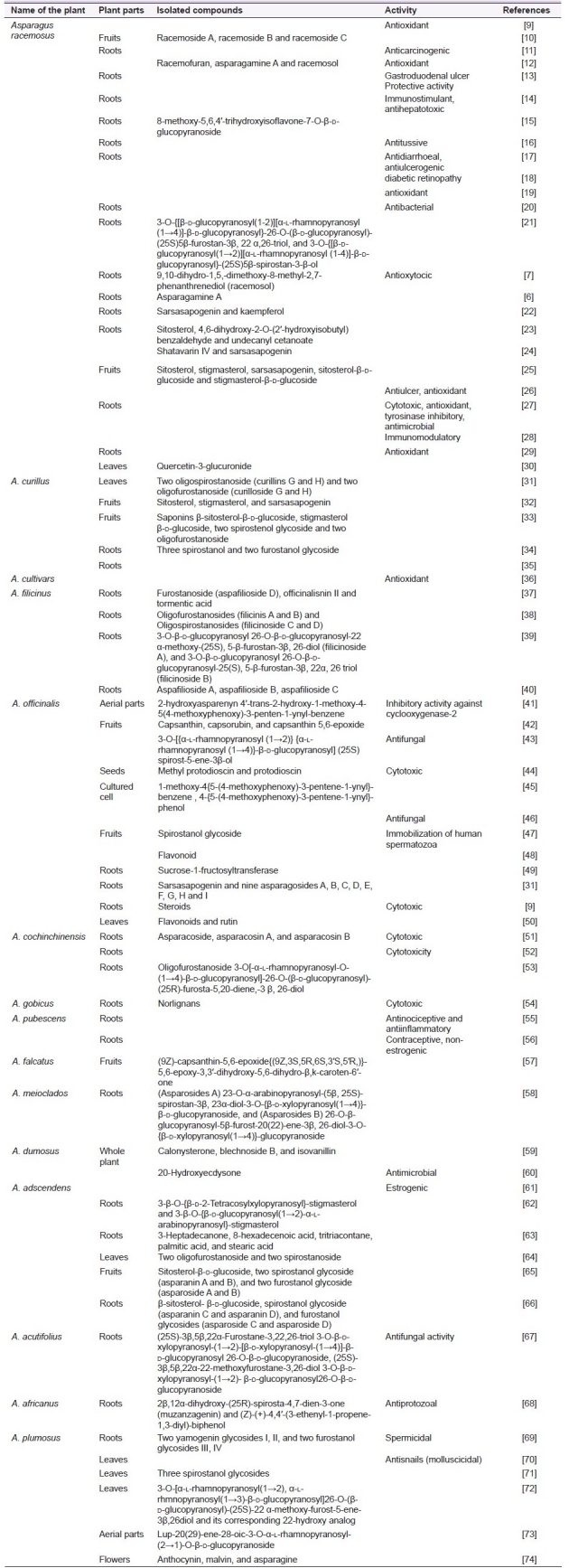Abstract
Asparagus species (family Liliaceae) are medicinal plants of temperate Himalayas. They possess a variety of biological properties, such as being antioxidants, immunostimulants, anti-inflammatory, antihepatotoxic, antibacterial, antioxytocic, and reproductive agents. The article briefly reviews the isolated chemical constituents and the biological activities of the plant species. The structural formula of isolated compounds and their distribution in the species studied are also given.
Keywords: Asparagus species, isolated compounds, sarsasapogenin, steroidal saponins
INTRODUCTION
Asparagus species, belonging to the family Liliaceae, are native medicinal shrubs valued for their medicinal properties. The genus Asparagus includes about 300 species around the world. The roots of Asparagus are the main source of the drug shatawar, the crude drug also used for increasing the secretion of milk and improving appetite in lactating women. Ripe fruits of Asparagus curillus cause abortion, tuberous roots with honey are given in dysuria, diabetes, and dysentery.[1] The roots of Asparagus racemosus are bitter, sweet oleaginous, cooling, and indigestible, appetizer, and are useful in dysentery, tumors, inflammation, biliousness, leprosy, epilepsy, and night blindness.[2] In Unani system, the roots are used as laxatives, tonic, aphrodisiac, galactogogue, and in disease of kidney and liver. Shoots contain thiophene, thiazole, aldehyde, ketone vanillin, asparagusic acid, and its methyl and ethyl esters used as flavors. Flowers and mature fruits contain quercetin, rutin (2.5% dry basis), and hyperoside, and the leaves contain diosgenin and quercetin-3-glucuronide. A. racemosus roots mainly contain 4 saponins, for example, shatavarin I–IV, the glycosides of sarsasapogenin. Roots of A. racemosus are also used against jaundice.
The bark exhibited antibacterial and antifungal activity. The powdered roots contain 2.95% protein, 5.44% saponins, 52.89% carbohydrate, 17.93% crude fiber, 4.18% inorganic matter, and 5% oil. The root of Asparagus officinalis is more diuretic than its shoot, and the root is recommended in dropsy and is a powerful cardiac sedative. Its roots have been used as a remedy for schistosomiasis and tuberculosis. The roots of Asparagus filicinus are considered as tonic, astringent, and vermifuge. In India and China, this plant is given as a powerful diuretic in cholera and rheumatism.[3] Ancient Grecians and Romans used Asparagus for its diuretic properties. It helps flush out the kidneys and help in the prevention of the formation of kidney stones. Chinese pharmacists save the best Asparagus roots for their families and friends, believing that it will increase feelings of compassion and love. In India, it is used to promote fertility, reduce menstrual cramping, and increase milk production in nursing mothers. Asparagus acts to increase cellular activity in the kidneys and thus increases the rate of urine production.
CHEMICAL CONSTITUENTS
The major bioactive constituents of Asparagus are a group of steroidal saponins. This plant also contains vitamins A, B1, B2, C, E, Mg, P, Ca, Fe, and folic acid. Other primary chemical constituents of Asparagus are essential oils, asparagine, arginine, tyrosine, flavonoids (kaempferol, quercetin, and rutin), resin, and tannin.
Shatavarin IV is a glycoside of sarsasapogenin having 2 molecules of Asparagus rhamnose and 1 molecule of glucose [Figure 1]. The major bioactives (Chemical constituents) of Asparagus species are shown in Figure 2. Sarsasapogenin and shatavarin I-IV are present in roots, leaves, and fruits of Asparagus species. Synthesis of sarsasapogenin in the callus culture of A. racemosus was also reported.[4] A new isoflavone, 8-methoxy-5,6,4’-trihydroxyisoflavone-7-O-β-D-glucopyranoside was also reported from A. racemosus previously.[5] The isolation and characterization of polycyclic alkaloid called asparagamine,[6] a new 9,10-dihydrophenanthrene derivative named racemosol and kaempferol were also isolated from the ethanolic root extract of A. racemosus.[7] Oligofurostanosides (curillins G and H) and spirostanosides (curilloside G and H) [Figure 2] have been isolated from the roots and sarsasapogenin from leaves of A. curillus. Isolated compounds and biological activities of Asparagus species are listed in Table 1.
Figure 1.

Structures of sarsasapogenin and its glycosides
Figure 2.

Isolated compounds from Asparagus species
Table 1.
Isolated compounds and activities of the different parts of Asparagus species

PROPERTIES
The structural complexity of saponins results in a number of physical, chemical, and biological properties. Saponins are usually amorphous substances having a high molecular weight. These are soluble in water and produce foam but organic solvents, such as chloroform, acetone, and ether inhibit their foaming property. Solubility of saponins is also affected by the properties of the solvent (as affected by temperature, composition, and pH), whereas water, alcohols (methanol, ethanol), and aqueous alcohols are the most common extraction solvents for saponins. Due to the presence of a lipid-soluble aglycone and water soluble sugar chain in their structure (amphiphilic nature), saponins are surface active compounds with detergent, wetting, emulsifying, and foaming properties. In aqueous solutions surfactants form micelles above a critical concentration called critical micelle concentration (cmc).
Saponins possess a variety of biological properties, namely, being antioxidants, immunostimulants, antihepatotoxic, antibacterial, useful in diabetic retinopathy, anticarcinogenic, antidiarrheal, antiulcerogenic, antioxytocic, and reproductive agents. Many saponins are known to be antimicrobial to inhibit mould and to protect plants from insects. They may be considered as defense system and have been included in a large group of protective molecules found in plants named phytoanticipins or phytoprotectants. Saponin-rich plants have been found to improve growth, feed efficiency, and health in ruminants.[8]
CONCLUSION
The literature survey revealed that the steroidal saponins are the main biologically active constituents of genus Asparagus. There is a wide disparity in the structures of bioactive compounds ranging from sulfur containing carboxylic acids, chalcones, steroidal sapogenins, and saponins.
ACKNOWLEDGMENT
The authors are thankful to Dr. Asha Budakoti, NCL, Pune, for providing some references.
Footnotes
Source of Support: Nil,
Conflict of Interest: None declared.
REFERENCES
- 1.Gaur RD. Srinagar: Garhwal; 1999. The Flora of the District Garhwal North West Himalaya; p. 170. [Google Scholar]
- 2.Kirtikar KR, Basu BD. Indian Medicinal Plants. In: Singh B, Singh MP, editors. Dehradun India: New Connaught Place; 1984. p. 2499. [Google Scholar]
- 3.Vol. 1. New Delhi: 1985. CSIR. The Wealth of India; pp. 468–71. [Google Scholar]
- 4.Kar DK, Sen S. Sarsasapogenin in callus culture of Asparagus racemosus. Curr Sci. 1985;54:585. [Google Scholar]
- 5.Saxena VK, Chaurasia S. A new isoflavone from the roots of Asparagus racemosus. Fitoterapia. 2001;72:307–9. doi: 10.1016/s0367-326x(00)00315-4. [DOI] [PubMed] [Google Scholar]
- 6.Sekine T, Fukasawa N, Kashiwagi Y, Ruangrungsi N, Murakoshi I. Structure of asparagamine A: A novel polycyclic alkaloid from Asparagus racemosus. Chem Pharm Bull. 1994;42:1360–2. [Google Scholar]
- 7.Sekine T, Fukasawa N, Murakoshi I, Ruangrungsi N. A 9,10-dihydrophenanthrene from Asparagus racemosus. Phytochemistry. 1997;44:763–4. [Google Scholar]
- 8.Mader TL, Brumm MC. Effect of feeding sarsasaponin in cattle and swine diets. J Anim Sci. 1987;65:9–15. doi: 10.2527/jas1987.6519. [DOI] [PubMed] [Google Scholar]
- 9.Velavan S, Nagulendran K, Mahesh R, Begum HV. In vitro antioxidant activity of Asparagus racemosus root. Pharmacog Mag. 2007;3:26–33. [Google Scholar]
- 10.Mandal D, Banerjee S, Mandal NB, Chakravarty AK, Sahu NP. Steroidal saponins from the fruits of Asparagus racemosus. Phytochemistry. 2006;67:1316–21. doi: 10.1016/j.phytochem.2006.04.005. [DOI] [PubMed] [Google Scholar]
- 11.Agrawal A, Ghosh NN, Tiwari M, Chandra R. New Delhi, India: Chemistry Biology Interface, Synergistic New Frontiers; 2004. Identification and characterization of the active principles of A. racemosus and an evaluation of their anticarcinogenic activity in an animal modle. [Google Scholar]
- 12.Wiboonpun N, Phuwapraisirisan P, Tip-pyang S. Identification of antioxidant compound from Asparagus racemosus. Phytother Res. 2004;18:771–1. doi: 10.1002/ptr.1526. [DOI] [PubMed] [Google Scholar]
- 13.Sairam K, Priyambada S, Aryya NC, Goel RK. Gastroduodenal ulcer protective activity of Asparagus racemosus: An experimental, biochemical and histological study. J Ethnopharmacol. 2003;86:1–10. doi: 10.1016/s0378-8741(02)00342-2. [DOI] [PubMed] [Google Scholar]
- 14.Muruganandan S, Garg H, Lal J, Suresh C, Dinesh K. Studies on the immunostimulant and antihepatotoxic activities of Asparagus racemosus root extract. J Med Aromat Plant Sci. 2001;22:49–52. [Google Scholar]
- 15.Saxena VK, Chourasia S. A new isoflavone from the roots of Asparagus racemosus. Fitoterapia. 2001;72:307–9. doi: 10.1016/s0367-326x(00)00315-4. [DOI] [PubMed] [Google Scholar]
- 16.Mandal SC, Kumar CK, Mohana Lakshmi S, Sinha S, Murugesan T, Saha BP, et al. Antitussive effect of Asparagus racemosus root against sulfur dioxide-induced cough in mice. Fitoterapia. 2000;71:686–9. doi: 10.1016/s0367-326x(00)00151-9. [DOI] [PubMed] [Google Scholar]
- 17.Nwafor PA, Okwuasaba FK, Binda LG. Antidiarrhoeal and antiulcerogenic effects of methanolic extract of Asparagus pubescens root in rats. J Ethnopharmacol. 2000;72:421–7. doi: 10.1016/s0378-8741(00)00261-0. [DOI] [PubMed] [Google Scholar]
- 18.Sharma S, Shrikant, Sahu M. Effect of shatavari on diabetic retionopathy. Proceedings of International Congress on Ayurveda-2000. Proceedings of International Congress on Ayurveda-2000. Chennai, India. 2000:85–6. [Google Scholar]
- 19.Kamat JP, Boloor KK, Devasagayam TP, Venkatachalam SR. Antioxidant properties of Asparagus racemosus against damage induced by gamma-radiation in rat liver mitochondria. J Ethnopharmacol. 2000;73:425–35. doi: 10.1016/s0378-8741(00)00176-8. [DOI] [PubMed] [Google Scholar]
- 20.Mandal SC, Nandy A, Pal M, Saha BP. Evaluation of antimicrobial activity of Asparagus racemosus Willd: Root. Phytother Res. 2000;14:118–9. doi: 10.1002/(sici)1099-1573(200003)14:2<118::aid-ptr493>3.0.co;2-p. [DOI] [PubMed] [Google Scholar]
- 21.Hayes PY, Jahidin AH, Lehmann R, Penman K, Kitching W, De Voss JJ. Structural revision of shatavarins I and IV, the major components from the roots of Asparagus racemosus. Tetrahedron Lett. 2006;47:6965–9. [Google Scholar]
- 22.Ahmad S, Ahmad S, Jain PC. Chemical examination of Satavari (Asparagus racemosus) Bull Medico Ethnobotanical Res. 1991;12:157–60. [Google Scholar]
- 23.Singh J, Tiwari HP. Chemical examination of roots of Asparagus racemosus. J Indian Chem Soc. 1991;68:427–8. [Google Scholar]
- 24.Ravikumar PR, Soman R, Chetty GL, Pandey RC, Sukhdev Chemistry of Ayurvedic Crude Drugs: Part VI-(Shatavari-1): Structure of Shatavarin-IV. Indian J Chem. 1987;26:1012–7. [Google Scholar]
- 25.Sharma SC, Sati OP, Chand R. A new isoflavone from the roots of Asparagus racemosus. Pharmazie. 1981;36:709. [Google Scholar]
- 26.Bhatnagar M, Sisodia SS, Bhatnagar R. Antiulcer and antioxidant activity of Asparagus racemosus Willd and Withania somnifera Dunal in rats. Ann N Y Acad Sci. 2005;1056:261–78. doi: 10.1196/annals.1352.027. [DOI] [PubMed] [Google Scholar]
- 27.Potduang B, Meeploy M, Giwanon R, Benmart Y, Kaewduang M, Supatanakul W. Biological activities of Asparagus racemosus. Afr J Tradit Complement Altern Med. 2008;5:230–7. doi: 10.4314/ajtcam.v5i3.31278. [DOI] [PMC free article] [PubMed] [Google Scholar]
- 28.Gautam M, Saha S, Bani S, Kaul A, Mishra S, Patil D, et al. Immunomodulatory activity of Asparagus racemosus on systemic Th1/Th2 immunity: Implications for immunoadjuvant potential. J Ethnopharmacol. 2009;121:241–7. doi: 10.1016/j.jep.2008.10.028. [DOI] [PubMed] [Google Scholar]
- 29.Visavadiya NP, Narasimhacharya AV. Asparagus root regulates cholesterol metabolism and improves antioxidant status in hypercholesteremic rats. Evid Based Complement Alternat Med. 2009;6:219–26. doi: 10.1093/ecam/nem091. [DOI] [PMC free article] [PubMed] [Google Scholar]
- 30.Rastogi RP, Mehrotra BN. New Delhi: Central Drug Research Institute, Lucknow and Publications & Information Directorate; 1969. Compendium of Indian Medicinal Plants; pp. 49–50. [Google Scholar]
- 31.Sharma SC, Sharma HC. Oligofurostanosides from Asparagus curillus leaves. Phytochemistry. 1993;33:683–6. doi: 10.1016/0031-9422(93)85473-5. [DOI] [PubMed] [Google Scholar]
- 32.Sharma SC, Sati OP, Chand R. Steroidal constituents of different parts of Asparagus curillus Buch. Ham Curr Sci. 1982;51:280–1. [Google Scholar]
- 33.Sharma SC, Sati OP, Chand R. Steroidal saponins from Asparagus curillus fruits. Planta Med. 1983;47:117–20. doi: 10.1055/s-2007-969968. [DOI] [PubMed] [Google Scholar]
- 34.Sharma SC, Sati OP, Chand R. Steroidal saponins of Asparagus curillus. Phytochemistry. 1982;21:1711–4. doi: 10.1055/s-2007-969968. [DOI] [PubMed] [Google Scholar]
- 35.Sati OP, Pant G. New furostanol glycosides from Asparagus plumosus Leaves. J Nat Prod. 1985;48:390–4. [Google Scholar]
- 36.Rodriguez R, Jaramillo S, Rodriguez G, Espejo JA, Guillen R, Fernandez-Bolanos J, et al. Antioxidant activity of ethanolic extracts from several Asparagus cultivars. J Agric Food Chem. 2005;53:5212–7. doi: 10.1021/jf050338i. [DOI] [PubMed] [Google Scholar]
- 37.Li YF, Hu LH, Lou FC, Hong JR, Li J, Shen Q. Furostanoside from Asparagus filicinus. J Asian Nat Prod Res. 2005;7:43–7. doi: 10.1080/10286020310001617110. [DOI] [PubMed] [Google Scholar]
- 38.Sharma SC, Thakur NK. Oligofuranosides and oligospiranosides from roots of Asparagus filicinus. Phytochemistry. 1996;42:599–603. doi: 10.1016/0031-9422(95)00549-8. [DOI] [PubMed] [Google Scholar]
- 39.Sharma SC, Sharma HC. Oligofuro and spirostanosides of Asparagus adscendens. Phytochemistry. 1984;23:645–8. [Google Scholar]
- 40.Ding Y, Yang CR. Steroidal saponins from Asparagus filicinus. Yao Xue Xue Bao. 1990;25:509–14. [PubMed] [Google Scholar]
- 41.Jang DS, Cuendet M, Fong HH, Pezzuto JM, Kinghorn AD. Constituents of Asparagus officinalis Evaluated for Inhibitory Activity against cyclooxygenase-2. J Agric Food Chem. 2004;52:2218–22. doi: 10.1021/jf0305229. [DOI] [PubMed] [Google Scholar]
- 42.Deli J, Matus Z, Toth G. Carotenoid composition in the fruits of Asparagus officinalis. J Agric Food Chem. 2000;48:2793–6. doi: 10.1021/jf991243h. [DOI] [PubMed] [Google Scholar]
- 43.Makoto S, Masayuki S, Makiko M. Kenji Watanabe, An Antifungal Saponin from White Asparagus (Asparagus officinalis L) Bottoms. J Sci Food Agric. 1996;72:430–4. [Google Scholar]
- 44.Shao Y, Poobrasert O, Kennelly EJ, Chin CK, Ho CT, Huang MT, et al. Steroidal saponins from Asparagus officinalis and their cytotoxic activity. Planta Med. 1997;63:258–62. doi: 10.1055/s-2006-957667. [DOI] [PubMed] [Google Scholar]
- 45.Terada K, Honda C, Suwa K, Takeyama S, Oku H, Kamisako W. Acetylenic compounds isolated from cultured cells of Asparagus officinalis. Chem Pharm Bull. 1995;43:564–6. doi: 10.1248/cpb.43.564. [DOI] [PubMed] [Google Scholar]
- 46.Shimoyamada M, Suzuki M, Sonta H, Maruyama M, Okubo K. Antifungal activity of the saponin fraction obtained from Asparagus officinalis L and its active principle. Agric Biol Chem. 1990;54:2553–7. [Google Scholar]
- 47.Pant G, Panwar MS, Negi DS, Rawat MS, Morris GA. Spirostanol glycoside from fruits of Asparagus officinalis. Phytochemistry. 1988;27:3324–5. [Google Scholar]
- 48.Kartnig TH, Gruber A, Stachel J. Zur Kenntnis des Flavonoidmusters von Asparagus officinalis. Planta Med. 1985;3:288. [Google Scholar]
- 49.Rastogi RP, Mehrotra BN. Vol. 2. New Delhi: Central Drug Research Institute, Lucknow and Publications & Information Directorate; 1979. Compendium of Indian Medicinal Plants; pp. 80–1. [Google Scholar]
- 50.Huang XF, Lin YY, Kong LY. Steroids from the roots of Asparagus officinalis and their cytotoxic activity. J Integr Plant Biol. 2008;50:717–22. doi: 10.1111/j.1744-7909.2008.00651.x. [DOI] [PubMed] [Google Scholar]
- 51.Zhang HJ, Sydara K, Tan GT, Ma C, Southavong B, Soejarto DD, et al. Bioactive constituents from Asparagus cochinchinensis. J Nat Prod. 2004;67:194–200. doi: 10.1021/np030370b. [DOI] [PubMed] [Google Scholar]
- 52.Koo HN, Jeong HJ, Choi JY, Choi SD, Choi TJ, Cheon Y, et al. Inhibition of tumor necrosis factor-alpha-induced apoptosis by Asparagus cochinchinensis in Hep G2 cells. J Ethnopharmacol. 2000;73:137–43. doi: 10.1016/s0378-8741(00)00287-7. [DOI] [PubMed] [Google Scholar]
- 53.Liang ZZ, Aquino R, De Simone F, Dini A, Schettino O, Pizza C. Oligofurostanosides from Asparagus cochinchinensis. Planta Med. 1988;54:344–6. doi: 10.1055/s-2006-962453. [DOI] [PubMed] [Google Scholar]
- 54.Yang CX, Huang SS, Yang XP, Jia ZJ. Nor-lignans and steroidal saponins from Asparagus gobicus. Planta Med. 2004;70:446–51. doi: 10.1055/s-2004-818974. [DOI] [PubMed] [Google Scholar]
- 55.Nwafor PA, Okwuasaba FK. Anti-nociceptive and anti-inflammatory effects of methanolic extract of Asparagus pubescens root in rodents. J Ethnopharmacol. 2003;84:125–9. doi: 10.1016/s0378-8741(02)00213-1. [DOI] [PubMed] [Google Scholar]
- 56.Nwafor PA, Okwuasaba FK, Onoruvwe OO. Contraceptive and non-estrogenic effects of methanolic extract of Asparagus pubescens root in experimental animals. J Ethnopharmacol. 1998;62:117–22. doi: 10.1016/s0378-8741(98)00021-x. [DOI] [PubMed] [Google Scholar]
- 57.Molnar P, Deli J, Toth G, Haberli A, Pfander H, Bernhard K. (9Z)-Capsanthin-5,6-epoxide, a New Carotenoid from the fruits of Asparagus falcatus. J Nat Prod. 2001;64:1254–5. doi: 10.1021/np0101447. [DOI] [PubMed] [Google Scholar]
- 58.Feng J, Chen DF, Sun QZ, Nakamura N, Hattori M. Asparosides A and B, two new steroidal saponins from Asparagus meioclados. J Asian Nat Prod Res. 2002;4:221–6. doi: 10.1080/10286020290028983. [DOI] [PubMed] [Google Scholar]
- 59.Khaliq-uz-Zaman SM, Simin K, Ahmad VU. Chemical constituents from Asparagus dumosus. Fitoterapia. 2000;71:331–3. doi: 10.1016/s0367-326x(99)00154-9. [DOI] [PubMed] [Google Scholar]
- 60.Ahmad VU, khaliq-Uz-Zaman SM, Ali MS, Perveen S, Ahmed W. Atibacterial ecdysone from Asparagus dumosus. Fitoterapia. 1996;67:88–91. [Google Scholar]
- 61.Kaur H. Estrogenic activity of some herbal galactogogue constituents. Ind J Anim Nutr. 1998;5:232–4. [Google Scholar]
- 62.Tandon M, Shukla YN, Thakur RS. Constituents of Asparagus adscendens. Fitoterapia. 1990;61:473. [Google Scholar]
- 63.Tandon M, Shukla YN, Thakur RS. Steroid glycosides from Asparagus adscendens. Phytochemistry. 1990;29:2957–9. [Google Scholar]
- 64.Sharma SC, Thakur NK. Furostanosides from Asparagus filicinus roots. Phytochemistry. 1994;36:469–71. doi: 10.1016/s0031-9422(00)97097-3. [DOI] [PubMed] [Google Scholar]
- 65.Sharma SC, Chand R, Sati OP. Steroidal Saponins of Asparagus adscendens. Phytochemistry. 1982;21:2075–8. [Google Scholar]
- 66.Sharma SC, Chand R, Bhatti BS, Sati OP. New oligospirostanosides and oligofurostanosides from Asparagus adscendens roots. Planta Med. 1982;46:48–51. doi: 10.1055/s-2007-970018. [DOI] [PubMed] [Google Scholar]
- 67.Sautour M, Miyamoto T, Lacaille-Dubois M. Steroidal saponins from Asparagus acutifolius. Phytochemistry. 2007;68:2554–62. doi: 10.1016/j.phytochem.2007.02.033. [DOI] [PubMed] [Google Scholar]
- 68.Oketch-Rabah HA, Dossaji SF, Christensen SB, Frydenvang K, Lammich E, Cornett C, et al. Antiprotozoal compounds from Asparagus africanus. J Nat Prod. 1997;60:1017–22. doi: 10.1021/np970217f. [DOI] [PubMed] [Google Scholar]
- 69.Pant G, Panwar MS, Negi DS, Zagorski M. Steroidal glycosides of the roots of Asparagus plumosus baker. Herba Polonica. 1988;34:175–81. [Google Scholar]
- 70.Sati OP, Pant G, Hostettmann K. Potent molluscicides from Asparagus. Pharmazie. 1984;39:581. [PubMed] [Google Scholar]
- 71.Sati OP, Pant G. Spirostanol glycosides from Asparagus plumosus. Phytochemistry. 1985;24:123–6. [Google Scholar]
- 72.Sati OP, Sharma SC. New steroidal glycosides from Asparagus curillus (roots) Pharmazie. 1985;40:417–8. [Google Scholar]
- 73.Mandloi D, Sant PG. A Saponin from Asparagus gonocladus. Phytochemistry. 1981;20:1687–8. [Google Scholar]
- 74.Rastogi RP, Mehrotra BN. New Delhi: Central Drug Research Institute, Lucknow and Publications & Information Directorate; 1979. Compendium of Indian medicinal plants; p. 80. [Google Scholar]


